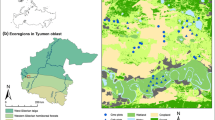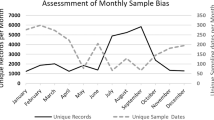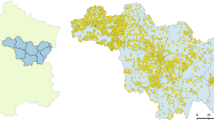Abstract
Kitahara and Fujii, in 1994, analyzed the butterfly communities along a gradient of human disturbance by applying the generalist/specialist concept. Butterfly species were classified into generalist or specialist species based on their voltinism (seasonal time dimension) and potential larval resource breadth (food dimension). The community structure and species composition showed the systematic changes along the gradient. To verify the generality of those trends, we monitored five grassland butterfly communities with varying degrees of human disturbance twice a month during 1985 by the line transect method at the foot of Mt. Fuji, central Japan, and analyzed their structure in a manner similar to that employed by Kitahara and Fujii. Most results were consistent with the patterns recognized by Kitahara and Fujii. The route (community) order based on increasing human disturbance was strongly and negatively correlated with butterfly species richness but with neither butterfly species diversity (H′) nor evenness (J′). Also, the degree of human disturbance was significantly and negatively correlated with the number of specialist species, but not with that of generalists, in a community. Butterfly species richness was more strongly correlated with the number of specialist species than with that of generalists. Our analyses also showed that the generalist species were distributed more widely over the communities than were the specialists. However, in contrast to the trend revealed by Kitahara and Fujii, there was no significant difference in the population densities and in the spatial population variability between the two species groups. As a whole, our analyses confirmed the consistency of most community patterns detected by Kitahara and Fujii. The causes of the inconsistencies in some patterns were thought to be mainly the present habitat conditions with a relatively short growing season at high altitudes.
Similar content being viewed by others
Author information
Authors and Affiliations
Additional information
Received: October 19, 1999 / Accepted: June 5, 2000
Rights and permissions
About this article
Cite this article
Kitahara, M., Sei, K. & Fujii, K. Patterns in the structure of grassland butterfly communities along a gradient of human disturbance: further analysis based on the generalist/specialist concept. Popul Ecol 42, 135–144 (2000). https://doi.org/10.1007/PL00011992
Issue Date:
DOI: https://doi.org/10.1007/PL00011992




